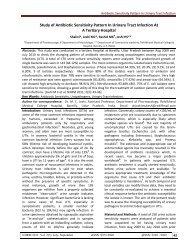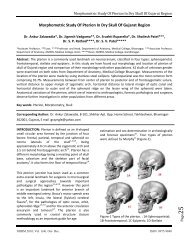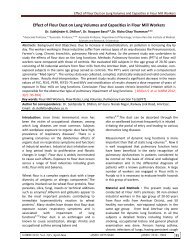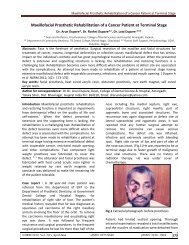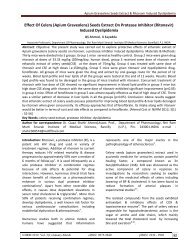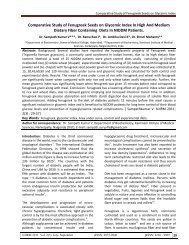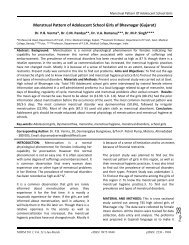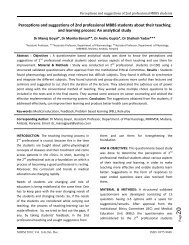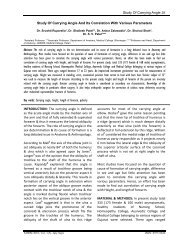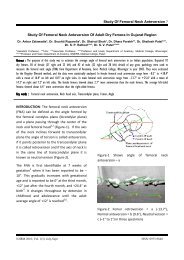Role Of Placenta To Combat Fluorosis - Njirm.pbworks.com
Role Of Placenta To Combat Fluorosis - Njirm.pbworks.com
Role Of Placenta To Combat Fluorosis - Njirm.pbworks.com
Create successful ePaper yourself
Turn your PDF publications into a flip-book with our unique Google optimized e-Paper software.
Page19<br />
<strong>Role</strong> <strong>Of</strong> <strong>Placenta</strong> <strong>To</strong> <strong>Combat</strong> <strong>Fluorosis</strong><br />
to F. Further, there is a need to translate similar<br />
type of <strong>com</strong>munity research into <strong>com</strong>munity health<br />
practice for the benefit of the population at large.<br />
The present study supports the view that the<br />
placenta has a protective role on fetus by<br />
preventing transfer of excess F to the growing fetus<br />
and the capacity of placenta as F filter is still a point<br />
of debate. When the drinking water and food has<br />
high F concentration, the F content of the placenta<br />
is significantly higher than that of the mother<br />
serum, while the cord blood has the least. Thus,<br />
these findings indicate that the placenta represents<br />
a natural barrier to the passage of larger quantities<br />
of F to the fetus probably by binding to calcium ions<br />
in the placenta. Further studies are essential to<br />
demonstrate and establish these observations.<br />
ACKNOWLEDGEMENTS : Authors are thankful to<br />
Kamineni Education Society for constant<br />
encouragement and funding for research. Dr<br />
Clareann H Bunker, Associate Professor,<br />
Department of Epidemiology, University of<br />
Pittsburgh, Pittsburgh, PA 15261 for her valuable<br />
suggestions in writing this manuscript. Patients of<br />
the study and their family members for their<br />
support and consent. Ms. Subhashini, Nursing<br />
Incharge, Dept. of Obstetrics and Gynecology, KIMS,<br />
for her help to collect samples.<br />
REFERENCES:<br />
1. WHO Guidelines for Drinking Water Equality,<br />
World Health Organisation, Geneva, 1984, 2:249<br />
2. BIS: 10500, “Indian Standard code for drinking<br />
water”, BIS, INDIA, 1983.<br />
3. Caldera R, Chavinie J, Fermanian J, <strong>To</strong>rtrat D,<br />
Laurent A M. Maternal- Fetal transfer of fluoride in<br />
pregnant women. Bio Neonate 1988; 54(5):263-9.<br />
4. Forestier F, Daffos F, Said R, Brunet CM,<br />
Guillaume PN. The passage of fluoride across<br />
placenta. An intra-uterine study. J. Gynecol Obstet<br />
Biol Reprod 1990; 19(2): 171-5.<br />
5. Shimonovitz S, Patz D, Ever- Hadani P, Singer L,<br />
Zacut D, Kidroni G, et al. Umbilical cord fluoride<br />
serum levels may not reflect fetal fluoride status. J<br />
Perinat Med 1995; 23(4): 279-82.<br />
6. Procedures for the collection of diagnostic<br />
blood specimens by venipuncture: Approved<br />
standard. 4 th ed. Wayne PA: National <strong>com</strong>mittee for<br />
Clinical Laboratory Standards, 1998.<br />
7. Procedures for handling and transport of<br />
domestic diagnostic specimens and etiologic agents:<br />
Approved standard. 3 rd ed. Wayne PA: National<br />
<strong>com</strong>mittee for Clinical Laboratory Standards, 1994.<br />
8. McArdle HJ, Douglas AJ & Morgan EH 1984<br />
Transferrin binding by microvillar vesicles isolated<br />
from rat placenta. <strong>Placenta</strong> 5 131–138.<br />
9. Angela M Finch, Li G Yang, Margaret O Nwagwu,<br />
Kenneth R Page, Harry J McArdle and Cheryl J<br />
Ashworth. <strong>Placenta</strong>l transport of leucine in a<br />
porcine model of low birth weight. Reproduction<br />
2004; 128: 229-35.<br />
10. Itaik, Tsunoda H. Highly sensitive and rapid<br />
method for determination of fluoride ion<br />
concentrations in serum and urine using flow<br />
injection analysis with a fluoride ion selective<br />
electrode. Clin Chim Acta 2001; 308:163-71.<br />
11. Feltman, R., and Kossel, G.: Prenatal Ingestion<br />
of Fluorides and Their Transfer to the Fetus. Science<br />
1955; 122:560.<br />
12. Li XS, Zhi JL, Gao RO, Effect of fluoride exposure<br />
on intelligence in children. Fluoride 1995. 28:189-<br />
192.<br />
13. Gupta S, Seth AK, Gupta A, Gavane AG.<br />
Transplacental passage of fluorides. J Pediatr<br />
1993; 1233(1):139-41.<br />
14. Shen YW, Taves DR. Fluoride concentrations in<br />
the human placenta and maternal and cord blood.<br />
Am J Obstet Gynecol 1974; 119 (2): 205-7.<br />
15. Opydo-Szymack, Borysewicz-Lewicka.<br />
Transplacental passage of Fluoride in pregnant<br />
Polish women assessed on the basis of Fluoride<br />
concentrations in maternal and cord blood plasma.<br />
Fluoride 2007; 40 (1): 46-50<br />
16. Malhotra A, Tewar A, Chawla HS, Gauba K, Dhall<br />
K. <strong>Placenta</strong>l transfer of Fluoride in pregnant women<br />
consuming optimum Fluoride in drinking water. J<br />
Indian Soc Pedod Prev Dent 1993; 11 (1): 1-3.<br />
17. Committee on <strong>To</strong>xicology, National Research<br />
Council of the National Academies. Health effects of<br />
Ingested Fluoride. Washington, DC: National<br />
Academy of Sciences Press; 1993.<br />
N NJIRM 2010; Vol. 1(4).Oct- Dec. ISSN: 0975-9840



